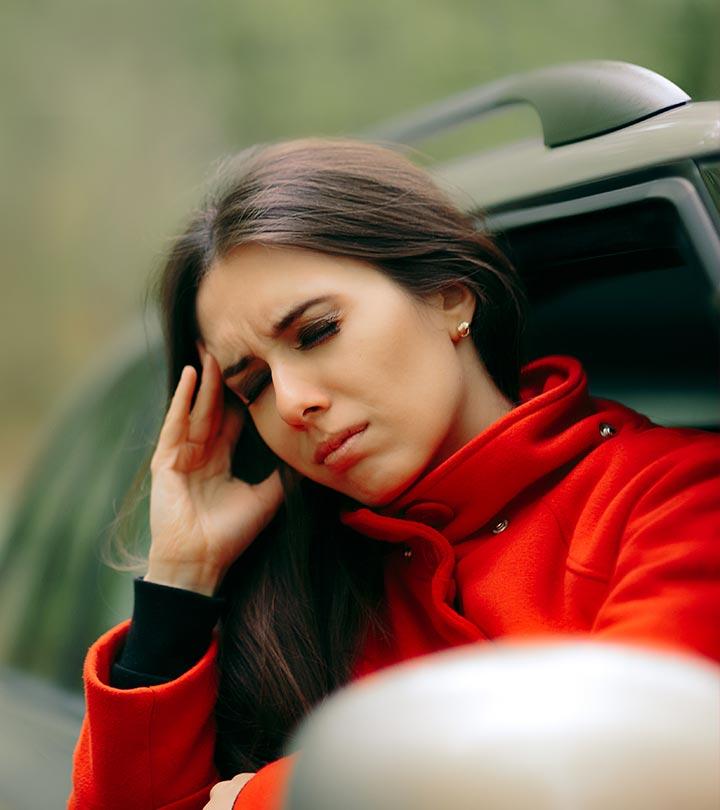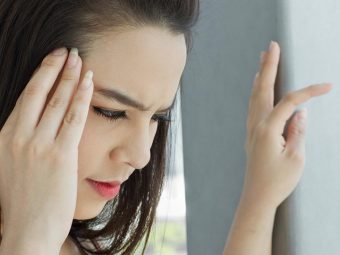9 Home Remedies For Motion Sickness, Treatment, & Prevention
Reduce the feeling of nausea and dizziness with some natural remedies.

Image: Shutterstock
Mal de debarquement or “sickness of embarkment” refers to where the sensation of motions during traveling can lead to motion-induced sickness. If you feel nausea and dizziness when you are traveling in a car, bus, or train, then you have motion sickness. While it is not harmful, it can cause a lot of distress to the person during the ride.
Many people suffer with car sickness, which can be a hassle The good news is that there are a few home remedies to get rid of motion sickness effectively. In this article, we explore some of the causes and the 9 best remedies to treat your motion sickness in a jiffy. Scroll down to the next section to know more!
In This Article
What Is Motion Sickness?
Motion sickness is a sensation of sickness or nausea that occurs when you are traveling by car, boat, plane, or train. Individuals prone to motion sickness usually become nauseous due to any kind of prolonged movements. If you are on a boat or ship, this condition is referred to as seasickness, but it involves the same phenomenon. If you are in a car for a long time, you can experience car sickness that results in similar symptoms. When you experience the same sickness during flights, it is called air sickness. There is also cyber sickness, which is caused by virtual simulations, 360-degree videos, and exposure to extreme digital virtual reality. It is also known as simulator sickness.
A 2019 international survey with 4,479 participants gives a fair idea of the current global prevalence of motion sickness. 46% of participants reported having experienced an episode of motion sickness as car passengers in the preceding five years. The incidence was highest while seating in the back seat (46.4%), followed by front seat positions (36.7%), and lowest at the driver position (17.2%). The frequently reported factors were multiple turns (71.8%), bad air quality (71.2%), and curvy roads (70.5%).
Motion sickness is mainly divided into three categories, depending on what triggers it.
Types Of Motion Sickness
- Motion sickness due to motion that is felt but not seen – This type of sickness is usually felt when you are traveling by road, air, or sea.
- Motion sickness due to motion that is seen but not felt – This type occurs when susceptible individuals are watching movies in a theater or in space.
- Motion sickness caused by motion that is seen and felt but fails to correspond – It usually happens inside a centrifuge or any environment where gravity is being stimulated by a centrifugal force.
Irrespective of the type of motion sickness, the signs and symptoms are the same.
Signs And Symptoms Of Motion Sickness
- Breaking out in cold sweat
- Dizziness
- Nausea
- An increase in salivary secretion
- Skin becomes pale
- Loss of appetite
Some individuals may also become very tired, get headaches, or have breathing problems. These symptoms most usually end up in vomiting if they are not alleviated in time.
To be able to manage the symptoms of motion sickness, you need to be aware of its causes and risk factors.
Causes Of And Risk Factors For Motion Sickness
Motion sickness is a result of conflict between your senses. Imagine you are on a fair ride, and it starts moving up and down. Your eyes are sensing movement, but your muscles conflict this sense. Your brain gets confused with all these mixed signals, and this is when you end up feeling dizzy or sick.
The medical term for motion sickness is kinetosis. Kinetosis happens as a result of conflict between the visual and vestibular systems (inner ear) of the body. The visual system signals the brain that the body is stationary, while the vestibular system informs the brain that the body is in motion. This vestibular dysfunction leads to motion-sickness symptoms, such as nausea and vomiting.
Factors that increase your risk of developing motion sickness are:
- Traveling
- Age – Those between 2 and 12 years are more susceptible.
- Gender – Women are at a higher risk than men.
- Sleep deprivation
- Alcohol
- Smoking
- A history of migraine
- Pregnancy
- Poor ventilation
Most of the time, the feeling of sickness due to motion tends to ease away once your body gets accustomed to its surroundings. However, if the symptoms prevail, you can try out any of the following natural remedies for immediate relief.
Home Remedies To Cure Motion Sickness
- Raw Ginger
- Essential Oils
- Lemon
- Pickle Juice
- Vitamins
- Chamomile Tea
- Licorice Root
- Stay Hydrated
- Black Horehound
How To Treat Motion Sickness Naturally
1. Raw Ginger
You Will Need
1 inch of peeled ginger
What You Have To Do
- Carry an inch of peeled ginger with you while traveling.
- Cut and suck on the small piece of ginger as soon as you commence your travel.
How Often You Should Do This
You must do this whenever you are traveling for a long duration.
Why This Works
Although the exact way in which ginger alleviates symptoms of motion sickness is unclear, many believe that the presence of gingerol and its strong flavor help ease nausea and other symptoms of motion sickness (1).
2. Essential Oils
a. Peppermint Oil
You Will Need
- 2-3 drops of peppermint oil
- A handkerchief
What You Have To Do
- Always carry a bottle of peppermint oil with you while traveling.
- Pour two to three drops of this oil on your handkerchief and sniff on it as you travel.
How Often You Should Do This
Follow this remedy as and when required.
Why This Works
Peppermint contains menthol that eases digestion. It also has a very strong aroma that helps prevent symptoms of nausea. All these activities help in treating motion sickness (2).
b. Ginger Oil
You Will Need
- 2-3 drops of ginger oil
- A handkerchief
What You Have To Do
- Put two to three drops of ginger oil on a handkerchief.
- Inhale the strong aroma.
How Often You Should Do This
You must do this only while traveling or when you experience motion sickness.
Why This Works
The strong aroma of ginger oil leaves you feeling better almost instantly. This is because of the antiemetic propertiesi XThe effect of a medical substance that treats vomiting and nausea that are common symptoms of motion sickness. of ginger (3).
3. Lemon
You Will Need
A lemon
What You Have To Do
- Always carry a lemon with you while traveling.
- You can either keep smelling the lemon or cut it into half and suck on it.
How Often You Should Do This
You only have to do this when you are experience motion sickness.
Why This Works
The acidic nature of lemons neutralizes your stomach acids and alleviates nausea. The strong and citrusy smell of lemons relieves symptoms of motion sickness (4).
4. Pickle Juice
You Will Need
1-2 teaspoons of pickle juice
What You Have To Do
Sip on small amounts of pickle juice whenever you feel nauseous or experience motion sickness.
How Often You Should Do This
Do this when required.
Why This Works
This remedy may help if your nausea is a result of an imbalance in your electrolyte levels. Anecdotal evidence suggests that pickle juice may help restore your electrolyte levels and balance the pH in your stomach. This prevents nausea, vomiting, and hangovers. However, there’s no scientific evidence for this claim.
5. Vitamins
B-vitamins like vitamins B6 and B12 are popularly used to alleviate the symptoms of motion sickness (5), (6). The same was also concluded by a study published in a peer-reviewed journal called Acta Astronautica in 1983.
You can either take supplements for these vitamins after consulting your doctor or consume vitamin-B rich foods like fish, meat, poultry, milk, and eggs. However, do not consume any of these foods if you are already experiencing motion sickness.
6. Chamomile Tea
You Will Need
- 1 teaspoon of chamomile tea
- 1 cup of water
What You Have To Do
- Bring a cup of water to a boil.
- Add a teaspoon of chamomile tea to it and simmer for 5 to 7 minutes.
- Strain and consume the tea after it becomes warm enough to drink.
How Often You Should Do This
Do this whenever you travel or experience motion sickness (also referred to as travel sickness).
Why This Works
Chamomile tea eases anxiety and makes you feel relaxed and peaceful. These activities have a positive effect on motion sickness and help in relieving its symptoms like nausea and vomiting (7).
Marianne, a YouTuber and functional nutritionist, demonstrated the preparation of chamomile and mint tea in one of her vlogs and shared her love for it: “I love chamomile tea; it is so soothing. It’s great for after a heavy meal; it’ll help you with digestion. When you’re super stressed and anxious, it helps you with that. We give it to our kids, you know, to soothe them as well (i).”
7. Licorice Root
You Will Need
- 1 teaspoon of licorice root
- 1 cup of water
What You Have To Do
- Bring a cup of water to a boil in a saucepan.
- Add a teaspoon of licorice root to the boiling water.
- Simmer for 5 minutes and strain.
- Allow the tea to cool a little before drinking.
How Often You Should Do This
You must do this only when the situation calls for it.
Why This Works
Licorice root has anti-inflammatory properties (8). It soothes your stomach and prevents symptoms of dyspepsiai XAlso known as indigestion is a condition that affects the upper abdomen of the body resulting in recurring pain and discomfort after a meal. (9). This reduces nausea along with the urge to vomit.
8. Stay Hydrated
Staying hydrated by drinking enough water and other fluids is another way to combat motion sickness. Dehydration usually worsens the symptoms of motion sickness – like vomiting and nausea.
9. Black Horehound
You Will Need
- 1 tablespoon of black horehound
- 1 cup of water
What You Have To Do
- Add a tablespoon of black horehound to a cup of water.
- Bring it to a boil in a saucepan.
- Simmer until the water becomes half of its initial volume and strain.
- Allow the mixture to cool and drink it as and when required.
How Often You Should Do This
You can carry this tea with you while traveling and drink it only if the motion sickness begins to set in.
Why This Works
One of the many uses of the black horehound herb is its ability to cure nausea and vomiting associated with motion sickness (10). This is due to the antiemetic properties it exhibits.
 Quick Tip
Quick TipThese were some of the natural remedies that can help you manage motion sickness. But if you are looking for an exercise to help you manage this condition, take a look at the next section to know more.
Motion Sickness Exercise
- Focus on a fixed point in the distance and avoid looking at moving objects or reading while in motion.
- Take slow, deep breaths to relax. Inhale deeply through your nose, hold for a few seconds, and then exhale slowly through your mouth.
- Do gentle neck stretches and shoulder rotations to reduce tension and discomfort in your upper body.
- Slowly tilt your head from side to side and then up and down to help your inner ear adjust to the motion.
- Engage in activities that require visual focus like playing games that involve spotting objects or patterns.
If you are looking for medical alternatives to cure motion sickness, there are quite a few of them as well. But, it is best to stick to natural remedies as they provide relief without causing any side effects. For instant relief, you can give any of the following treatments a shot.
Other Treatments
Medicines that are used to treat motion sickness include:
- Antihistaminesi XA group of over-the-counter (OTC) medicines that treat severe symptoms of motion sickness, different allergies, the common cold, and influenza. like Dimenhydrinate – It should be taken an hour before travel.
- Scopolamine
The side effects of most of these drugs include drowsiness and a dry mouth. However, these side effects are not much cause for concern.
It is best to prevent the onset of motion sickness. That means you need to take some precautions before motion sickness sets in to avoid experiencing its symptoms. Listed below are a few prevention tips that will help you.
Tips To Prevent Motion Sickness
- Be relaxed and don’t strain your body while traveling.
- Avoid activities like reading, writing, or typing in a moving vehicle.
- Avoid drinking alcohol, especially prior to traveling.
- Breathe in fresh air.
- Quit smoking.
 Quick Tip
Quick TipInfographic: Differences Between Motion Sickness And Vertigo
Motion sickness is a balance disorder often confused with another balance disorder called vertigo. While these two conditions share a few similarities, such as nausea, vomiting, and dizziness, they are quite different from each other.
Check out the infographic to explore the differences between motion sickness and vertigo. Illustration: StyleCraze Design Team
Save the high-quality PDF version on your device now.
Download Infographic
Motion sickness most frequently during travel and causes a sensation of nausea. Those prone to motion sickness can become nauseous due to prolonged movements that can be felt, seen, or both. Cold sweat, dizziness, nausea, headaches, pale skin, increased salivation, and vomiting are common symptoms of motion sickness. You may be most prone to experiencing motion sickness if you are traveling, sleep-deprived, have inadequate ventilation, are under the influence of alcohol consumption, or are pregnant. Home remedies for motion sickness include essential oils, raw ginger, lemon, pickle juice, vitamins, licorice root, and hydration.
Frequently Asked Questions
When should I see a doctor for motion sickness?
Motion sickness usually subsides on its own. But if you continue vomiting, feel dizzy, notice any hearing loss, or develop chest pain or headache, it is best to consult a doctor.
What is the best medicine for motion sickness?
Any of the medicines mentioned above – like Scopolamine or Dimenhydrinate – can help alleviate motion sickness. All the natural remedies work great too.
Where is the pressure point for motion sickness?
One of the most popular pressure points known to relieve symptoms of motion sickness is the P6 (Pericardium 6) acupressure point. This point is also referred to as Nei Guan and is widely used to relieve motion sickness and its symptoms. This point is located on the inner forearm, about three finger breadths below the wrist, between the two of your tendons.
How long does motion sickness last?
In general, motion sickness can last up to 4 hours. However, this might vary depending on the individual’s age and the severity of the condition.
Is motion sickness psychological?
Yes, motion sickness is connected to both psychological and physiological attributes. Studies link motion sickness with neuroticism (a personality trait characterized by anxiety and negative emotions) in women (11).
Can anxiety cause motion sickness?
While anxiety might not be the direct cause of motion sickness, it can contribute to its effect and further enhance its severity (12).
Can you train yourself not to get motion sickness?
While currently no research supports this statement, we can train our minds to combat motion sickness. Practicing diaphragmatic breathing techniques (deep breathing) can also help you mentally prepare yourself to deal with motion sickness.
Key Takeaways
- Motion sickness happens due to traveling, alcohol abuse, or sleepiness, which causes dizziness, nausea, and loss of appetite.
- To manage motion sickness, home remedies such as chewing or smelling ginger or lemon can help as their strong flavor alleviates nausea.
- Herbal teas such as ginger, chamomile and licorice root tea, or pickle juices help reduce motion sickness as they help restore electrolytes.
- Staying hydrated, getting enough fresh air and smelling peppermint oil are some simple ways to combat motion sickness as well.
Feeling dizzy, nauseous, and having headaches? Learn about the causes, symptoms, and treatments of motion sickness in this informative video.
Personal Experience: Sources
i)Feeling Anxious? Drink this Chamomile Tea! | The Frugal Chef
https://www.youtube.com/watch?v=ESAKyUO3FO8
Sources
Articles on StyleCraze are backed by verified information from peer-reviewed and academic research papers, reputed organizations, research institutions, and medical associations to ensure accuracy and relevance. Read our editorial policy to learn more.
- “Effects of ginger on motion sickness and gastric slow-wave dysrhythmias induced by circular vection” American Journal of Physiology: Gastrointestinal and Liver Physiology, US National Library of Medicine
- “Study of the Effect of Mint Oil on Nausea and Vomiting During Pregnancy” Iranian Red Crescent Medical Journal, US National Library of Medicine
- “Ginger in the prevention of nausea and vomiting: a review” Critical Reviews in Food Science and Nutrition, US National Library of Medicine
- “The Effect of Lemon Inhalation Aromatherapy on Nausea and Vomiting of Pregnancy: A Double-Blinded, Randomized, Controlled Clinical Trial” Iranian Red Crescent Medical Journal, US National Library of Medicine
- “An appraisal of the value of vitamin B12 in the prevention of motion sickness” Acta Astronautica, US National Library of Medicine
- “A randomized comparison of vitamin B6 and dimenhydrinate in the treatment of nausea and vomiting in early pregnancy” Iranian Journal of Nursing and Midwifery Research, US National Library of Medicine
- “Chamomile: A herbal medicine of the past with bright future” Molecular Medicine Reports, US National Library of Medicine
- “Anti-Inflammatory Effects of Licorice and Roasted Licorice Extracts on TPA-Induced Acute Inflammation and Collagen-Induced Arthritis in Mice” Journal of Biomedicine and Biotechnology, US National Library of Medicine
- “An Extract of Glycyrrhiza glabra (GutGard) Alleviates Symptoms of Functional Dyspepsia: A Randomized, Double-Blind, Placebo-Controlled Study” Evidence-Based Complementary and Alternative Medicine, US National Library of Medicine
- “THE PHARMACOLOGICAL IMPORTANCE OF BALLOTA NIGRA –A REVIEW” Indian Journal of Pharmaceutical Science And Research, ResearchGate
- “Physiological and psychological correlates of motion sickness” British Journal of Medical Psychology, PubMed
- “Motion sickness: more than nausea and vomiting” Experimental Brain Research, US National Library of Medicine




































